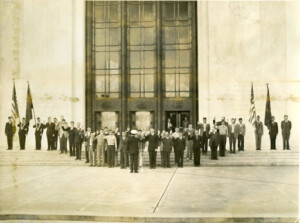World War II in Salem: Largest Population Increase Since 1890s

1942, Enlisting of “Oregon Avengers of Pearl Harbor”, Salem, Oregon, June 7, 1942 at 11:25 a.m. Navy Officer facing new recruits in front of Oregon State Capitol Building.
Color guard with flags of the United States and Oregon at right and left., WHC Collections 1986.066.0001
World War II created a booming economy in the United States. The economies of cities and towns across the country grew explosively during World War II and, especially, after the war. Between 1939 and 1945, goods produced in the United States, many of which went to support the war effort, jumped from $91 billion to $167 billion. During the same period, per capita disposable income increased by one-third, reaching $1,669 in 1945 for each man, woman, and child. Corporations and individuals, as well as state and local governments, were able to save a total of $58 billion by the end of the war, which contributed to a boom of enormous proportions immediately following the war.
The return of veterans after the war greatly expanded the male work force (from 55 million in 1945 to 67 million in 1960), and contributed to an enormous increase in population. New homes and entire subdivisions sprang up everywhere across the country, including in Salem. Individual incomes soared as well for most segments of the work force (except for farmers, whose income dropped substantially between 1952 and 1960). Never before had so many ordinary Americans experienced such affluence. More marriages, children, and disposable income translated into an insatiable demand for goods and services.
Changes in Salem during the 1940s reflected the National and local economic boom, as well as downtown commercial property owners’ efforts to counteract the emerging trend to construct suburban shopping centers with abundant parking for cars. Between 1940 and 1950, the population in the larger Salem metropolitan district jumped by more than 25%, from roughly 32,400 to 43,100, the largest percent increase in the state capital’s population since the 1890s. By 1949, Salem’s trading area population had increased to 215,000 (from 100,000 in 1940).
World War II Comes To The Fair
With the country engaged in World War II, the 1942 fair was scaled back to include only 4-H displays, livestock exhibits, and 27 county displays; it was not considered an official State Fair. During 1943 and 1944, operation of the fair was suspended entirely, and the grounds leased to military units as a place to bivouac. In the summer of 1943, at the request of the Willamette Valley Cherry Growers, the Fairgrounds became a labor camp for the Mexican workers needed to harvest the cherry crop.
The increased flow of money and people into Salem’s downtown commercial district could be seen in visible changes made to buildings. New buildings of modern design and function replaced a few of the district’s aging edifices, which had fallen into disrepair. On the eve of United State’s entry into World War II, sisters Dorothy and Helen Pearce replaced the Wade & Pearce Company Building (at 305-321 Court Street) with a smooth-surfaced, Modernistic- style retail block.
Building expansion as well as remodeling also occurred during the prosperous post-World War II period. Around 1950, the Hughes-Durbin Building (at 160 Liberty Street, NE), constructed in 1916, received a third-story addition and a facade modernization. One block to the west, the elaborately decorated, Italianate-style Breyman Brothers Block at 174-188 Commercial Street, built in 1874, was totally modernized in the late 1940s so that the smooth exterior surface and window placement mimicked the Modernistic style.
The Steusloff Building at 399 Court Street experienced a similar transformation in 1947-48 when the long-time owners modified this Queen Anne building with a Modernistic exterior. Nearly all modernization efforts involved the removal of decorative detail, resurfacing of the exterior facade, and updating of the ground-level storefronts. Importantly, the placement of windows above the first floor was usually left intact. These and a few other buildings that were remodeled in Salem’s commercial district during the 1940s convey a sense of the shared National history of economic prosperity and dynamic growth that took place in the Oregon’s state capital.
Compiled by Monica Mersinger
World War II Timeline
To learn more about the specifics of Salem’s involvement in World War II, please continue onto this next article which goes into every year of Salem’s involvement. Learn More
Bibliography:
Nomination report, National Register of Historic Places, Historic Downtown Salem application, July, 2001
Branaugh, Barry; and Dayna J. Collins, Susan Gibby, LaVerne Marker, Mark McKinney. “The Oregon State Fair: A History.”
This article originally appeared on the original Salem Online History site and has not been updated since 2006.







Leave A Comment